BUILT DURING PROHIBITION
Al’s Bar/Cafe/Place/Tavern/Liquor Store was built in 1926 at 3912 Excelsior Blvd. This two-story establishment was originally faced with red Chicago brick. We’re unsure of the original owner, but in 1927 Al J. Lovass and Mary Vlavianous obtained a license to sell soft drinks and operate a restaurant. (Read more about Al at the bottom of this page.) Others remember it as a grocery store or a confectionery. Whatever was going on upstairs, bootlegger Al supplied his customers with more than pop in his basement “party room”/speakeasy that featured a large stone fireplace. (The fireplace was demolished but family of the owners rescued several of the stones.) Al’s friendship with the Sheriff ensured that he and his card playing, drinking customers were safe from prosecution.
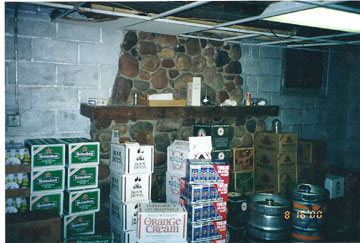
Co-owner David Payne says that Al operated a “drive-up liquor store.” His understanding is that “Al ran a country store selling potatoes and produce in the main building while using a brick garage out back for a covert bootlegging operation. The bootleggers would take money through one window and pass out bottles of liquor out the other.”
In 1933 the establishment was listed as Al’s Cafe in the first St. Louis Park Directory, reflecting its status before the end of prohibition the following year.
THE END OF PROHIBITION
The first addition, to the east, was built in 1934. This room originally had big windows so one could see the golf course, but in one misguided fit of remodeling the windows were covered over.
Al’s (“home of the giant double”) was an especially popular place when there was an election in Minneapolis and the Minneapolis bars were closed, since Al’s was the first bar across the city line.
Al was a friend to the workingman; he cashed upwards of $20,000 in payroll checks on Fridays, and opened at 8 a.m. to accommodate third shift workers who were just getting off work.
Al’s never closed because of inclement weather. During the Armistice Day Blizzard of 1940, people walked on top of cars to find refuge at Al’s, where they partied for 3-4 days.
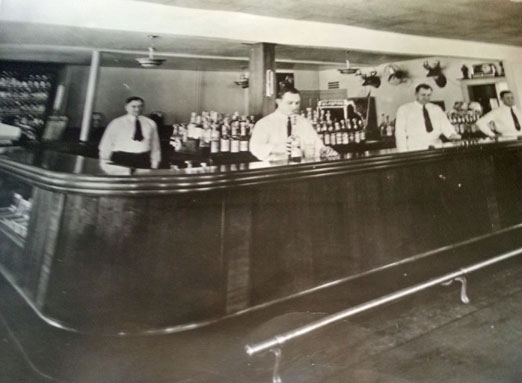
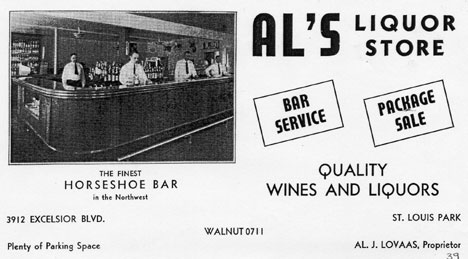
The ad below from 1942 shows the liquor store before the western addition was built.
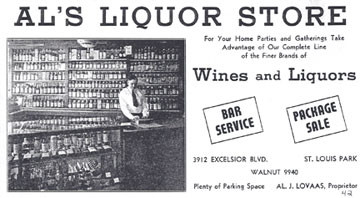
In 1952 the liquor store was added to the west side.
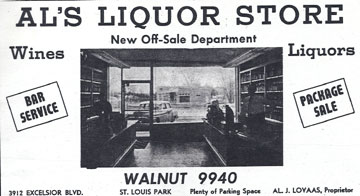
The liquor store closed in 1980. Because of regulations imposed by the City, the former liquor store could only be used for storage.
CLASSIC BARTENDERS
Ben Brown remembered that Al’s had a collection of “character bartenders:” Gar Case was a song and dance man from the old vaudeville days. He knew every joke and story ever told and liked to share them with his customers. If he started to tell a story he never quit until he finished, regardless of who was waiting for a drink. Another bartender was Knox Delaney. He had a diamond in one of his front teeth and loved to flash a big smile, especially to the ladies, so you could see the diamond.
The tradition of character bartenders continued with the saga of Butch the Bartender. These were in the days in the early 1950s when both WTCN-TV (at the Calhoun Beach Hotel just down Excelsior Blvd.) and WMIN (in St. Paul) shared the frequency and alternated during the day. During the time that WMIN was on the air, the guys (including the wrestlers) from WTCN would go down to Al’s, where they encountered Butch. It is an understatement to say that Butch was a character, according to Al DeRusha from WTCN. Unfortunately, most of his antics cannot be related here. Here’s one: when someone gave him a lousy tip, he’s shout so everyone could hear, “Is that all you can afford? Here, keep it (and he’d give it back) – you need it more than I do!”
One time DeRusha brought in reps from Schmidt beer and the ad agency from Detroit, along with Frank Beutel from WTCN who did the Schmidt commercials. DeRusha had called ahead and told Butch to give them the business. So they came in, introductions are made, and of course the group orders a Schmidt. Boy did Butch let them have it – “Schmidt? You’re in Minneapolis. In Minneapolis we drink Grain Belt! If you want that ### Schmidt, go to St. Paul and drink it!” But Butch relented and went to get a Schmidt. Al said “I hope it’s cold.” “Cold?” Butch exclaimed. “It’s been in the cooler for six months – nobody drinks that stuff!” So from then on, whenever the men from Detroit came to town, they made a mandatory stop at Al’s to see Butch.
AFTER AL
When Al died in 1952 his liquor license went to William C. Lovaas and NW National Bank as co-administrators of the estate. In 1960 partners were listed as Melvin D. Lovaas, Clair H. Reed, James H. Holme, Paul B. Haugejorden, and Woodrow W. Jones. Haugejorden became the manager/owner. He was a bachelor who lived upstairs at one point, and at Minikahda Court when he died in September 1966. Jim Holme, Al’s nephew, and Walter J. Holme, Al’s cousin, ran it from 1966 to at least 1977, when Jim Holme sold it to bartender Woody Jones and David Payne. Charles “Buzz” Griffin was the President of Al’s Liquors, Inc.
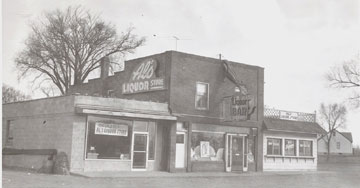
This undated picture shows the original building in brick and the two additions. It must have been taken between 1952 and 1956, when we see that the building had been stuccoed (see below). Note the giant beer bottle pouring a beer into a giant mug that says “Liquor Bar.”
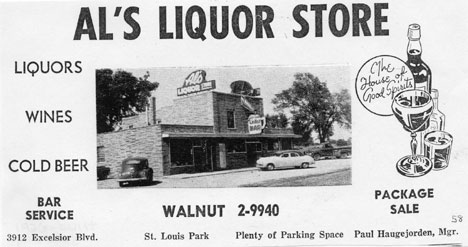
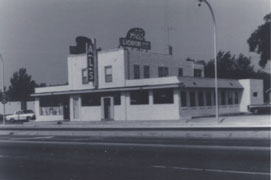
Al’s was a good neighbor, maintaining green space in the area and participating in civic activities such as Parktacular, National Night Out, and sports teams. Owners David Payne and Buzz Griffin were extremely cooperative with their neighbors in the Minikahda Oaks neighborhood, and they enjoyed an amicable relationship.
THE END OF AL’S
Because of its prime location at the threshold of the City, there were numerous plans to redevelop the site over the years, but none came through until 2009. The site was replaced with a new development called the Ellipse on Excelsior. This gateway project is comprised of a five-story commercial and luxury apartment complex.
All of the old regulars came for a last round on Friday, July 10, 2009, and a farewell party was given on the last day, July 11. The keys were turned over on the 13th. Fortunately, the famous “horseshoe bar” was removed and there are plans to bring it back to its former luster.
Al’s was demolished on Monday morning, July 20, 2009. Just like that, the old landmark was gone. The old regulars came to witness the event, no doubt with tears in their eyes. The developer was very accommodating, allowing the gallery to don hardhats and watch up close. Neighbors in their lawn chairs also witnessed the event, but then retreated to close the windows of their houses because of the awful stench of 83 years of stale beer and dust and mold and just old house.
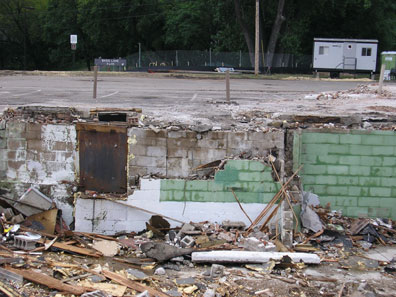
With the basement exposed, one could see where the original building was and the two additions on either side.
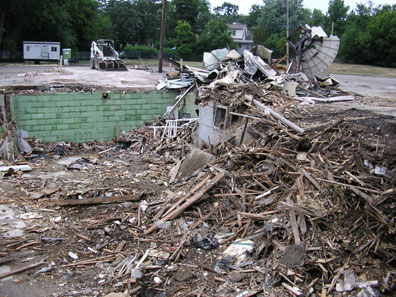
Piles of debris were pushed to the corners. No sign of the doomed fireplace.
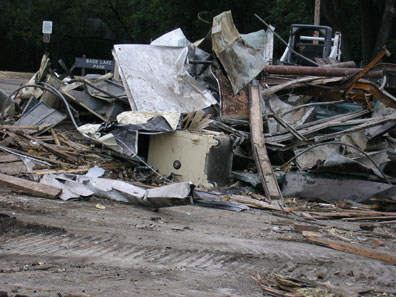
Ah, the stories that safe could tell…. Another old safe was saved by the family.
The next day, huge pieces of concrete were found underneath the parking lot. These may have had something to do with a ditch that was built in 1908 to channel water from Bass Lake into Lake Calhoun. A fleet of trucks moved the debris and dirt away, and excavation began for the underground parking of the new development.
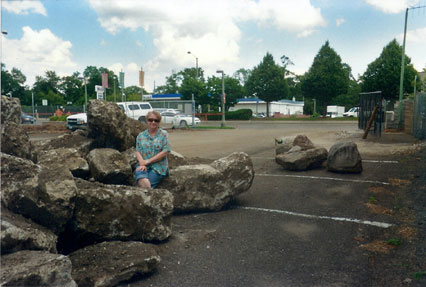
All was not lost: The American Legion immediately put up a banner saying “Welcome Al’s patrons.”
The St. Louis Park Historical Society has one of the bar’s signs, generously stored for us by Nordic Ware until we get a museum where we can display it. And we have one of the bar’s cash registers at the Historic Milwaukee Road Depot in Jorvig Park.
ALBIN J. LOVASS
Al was born on March 31, 1892, in Sauk Centre, Minnesota. Great niece Pat Wallraven tells us that “The Lovaases came from Norway in 1861. Albin’s father, Joseph Garibaldi Lovaas, was born at sea. His middle name is the name of the ship, Garibaldi. Not your average Norwegian name! Joseph Garibaldi Lovaas was a carpenter and mechanic. In 1923 Joseph was hit by an auto and died from the injuries.”
Al’s mother Annie was born in Norway. Joseph and Annie’s other children were:
- Eddie, born 1883
- Minda A., born 1885
- Jennie C., born 1887
- Robert J., born 1896
- Melvin D, born 1899
- William C., born 1901
Al’s wife was Lucille Ellen Hall (born September 9, 1880, died April 7, 1952).
Resources on Ancestry.com give this account of Al’s life:
1900: Sauk Centre
1910: Minneapolis
1912: Clerk, Berrier Mercantile Co.
1915: Salesman, Minneapolis
1917-18: Water Meter Inspector, City of Minneapolis
1919: Lovaas Auto and Machine Co., 3010 E. Lake Street, with Joseph G. and Robert J. Lovaas
1920: Al and Lucille lived in Minneapolis and he was a garage mechanic.
1930: Al was listed in the Census as a Carpenter and Lucille as the owner of a Confectionary. Their street is given as Excelsior Blvd. but no address is listed.
1932: Mechanic, Chamberlin Weather Strip Co., St. Louis Park
1935-1940: Lived above the bar. Milton P. Strehlow and Flora Boyle also lived there in 1940.
Al and Lucille lived above the bar until they bought a house in southwest Minneapolis in the 1940s.
John Reid remembered that Al wanted to sell the bar after WWII, but local attorney Heine Kuhlman talked them out of it because he knew it was a gold mine. “Heine was upset because they never gave him anything for that good advice.”
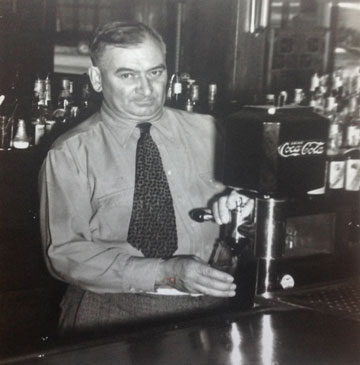
According to Wisconsin US Death Records, 1872-2004, Al died August 19, 1952 in Polk, Wisconsin. His grave is in Sunset Memorial Park.
